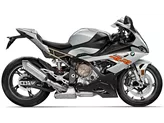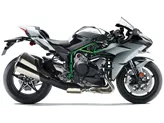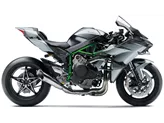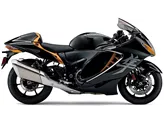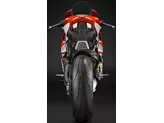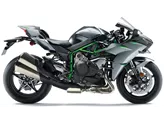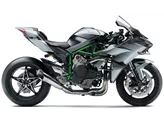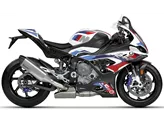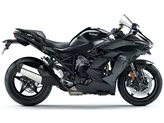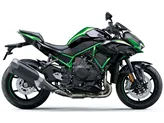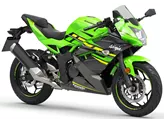Kawasaki Ninja H2 R 2015 vs. Kawasaki Ninja H2 2015

Kawasaki Ninja H2 R 2015

Kawasaki Ninja H2 2015
Overview - Kawasaki Ninja H2 R 2015 vs Kawasaki Ninja H2 2015
The Kawasaki Ninja H2 R model year 2015 is a supersport motorcycle that boasts impressive technical specifications. It is powered by an in-line engine with a displacement of 998ccm and has a bore and stroke of 76mm and 55mm, respectively. The engine delivers an impressive power output of 310 HP and a torque of 165 Nm, making it a powerhouse on the road. It features a compression ratio of 8.3 and has four cylinders with four valves per cylinder, all controlled by a DOHC system.
The suspension of the Ninja H2 R consists of a telescopic fork at the front and a single swing arm at the rear. Both the front and rear suspension offer adjustable compression, preload, and rebound settings, allowing the rider to fine-tune the bike's performance to their liking. The frame of the H2 R is made of steel and has a tubular design, providing a sturdy and stable platform for the motorcycle.
In terms of braking, the H2 R is equipped with double disk brakes at the front, utilizing radial technology for enhanced stopping power. The front tire has a width of 120mm and a diameter of 17 inches, while the rear tire has a width of 190mm and the same diameter. The wheelbase of the H2 R is 1450mm, providing stability and agility.
The seat height of the H2 R is 830mm, and it has a kerb weight of 216kg with ABS. The fuel tank has a capacity of 17 liters, ensuring sufficient range for long rides. The H2 R is known for its superb build quality, with high-quality details found throughout the motorcycle. The paintwork is also excellent, adding to the overall aesthetic appeal.

Kawasaki Ninja H2 R 2015
When it comes to strengths, the H2 R excels in several areas. It is praised for its quality of workmanship, with attention to detail evident in every aspect of the bike. The power, torque, and traction offered by the H2 R are exceptional, especially considering its low maintenance requirements compared to other motorcycles in the 300 hp league. The acceleration of the H2 R is described as being out of this world, providing a thrilling riding experience. The engine control is also highly regarded, offering precise and responsive performance. Additionally, the H2 R offers great stability in all situations, further enhancing the rider's confidence.
However, the H2 R does have some weaknesses. The engine response at the first few degrees of throttle can be a bit lacking, and understeer at high speeds has been reported. The H2 R also requires higher maintenance compared to regular motorcycles, which may be a consideration for some riders. Lastly, the sound produced by the H2 R's engine is described as infernal, which can be a love-it-or-hate-it aspect, but it may also cause issues on race tracks.
On the other hand, the Kawasaki Ninja H2 model year 2015 shares many similarities with the H2 R in terms of technical specifications. It also features an in-line engine with a displacement of 998ccm and has the same bore and stroke measurements. However, the H2 has a slightly lower power output of 200 HP and a torque of 133.5 Nm. The compression ratio is slightly higher at 8.5, and it also has four cylinders with four valves per cylinder controlled by DOHC.

Kawasaki Ninja H2 2015
The suspension, chassis, and braking systems of the H2 are identical to those of the H2 R. The front tire width is also the same at 120mm, but the rear tire is slightly wider at 200mm. The wheelbase of the H2 is slightly longer at 1455mm, and the seat height is slightly lower at 825mm. The kerb weight of the H2 is higher at 238kg with ABS, and the fuel tank capacity is the same at 17 liters.
In terms of strengths, the H2 shares many of the same positive attributes as the H2 R. It also offers outstanding build quality, with attention to detail evident throughout the motorcycle. The engine, with its mechanical turbocharger, is described as fascinating, providing unparalleled pull, acceleration, and speed. The narrow seat of the H2 ensures safe standing, even for smaller riders, and the overall stability of the bike inspires confidence. The H2 also features strong brakes and high-quality details, further adding to its appeal.
However, the H2 also has some weaknesses. The response behavior in the transition from pushing mode to acceleration phase is not at the same level as "normal" motorcycles, and understeer in fast bends has been reported. Additionally, riders taller than 185cm may find it difficult to integrate their feet into the overall aerodynamic concept of the bike.
In conclusion, both the Kawasaki Ninja H2 R and the Kawasaki Ninja H2 model year 2015 offer impressive performance and build quality. The H2 R stands out with its higher power output and lower weight, making it a true powerhouse on the road. However, the H2 also delivers exceptional performance and offers a more accessible option for riders. Ultimately, the choice between the two models will depend on individual preferences and priorities.
Technical Specifications Kawasaki Ninja H2 R 2015 compared to Kawasaki Ninja H2 2015
Pros and Cons in comparison
Pros and Cons in comparison
Kawasaki Ninja H2 R 2015

The Kawasaki crew had a vision. To build a motorbike that creates excitement and pushes into completely new dimensions in terms of performance and technology. This vision has succeeded. The 326 hp machine can be piloted by experienced riders without acute danger to their lives. The intensity of the acceleration is indescribable. But the perfect overall appearance of the motorbike with countless high-quality details is also thrilling. Compared to normal motorbikes, the H2 R has its weaknesses in throttle response and line precision at high speeds. All in all, the H2 R is the most fascinating motorbike of all time for the test pilot and can be recommended to petrol junkies with a clear conscience. The H2 R is available for the price of a well-equipped German-made premium estate - only with "a little" more adrenaline.
Kawasaki Ninja H2 2015

The Ninja H2 represents a milestone in motorbike history. It is not only packed with electronic innovations, but also offers completely new technologies in terms of engine construction and mechanics. This high-tech research object of a Japanese technology company is actually for sale and can also be ridden. Basically, it rides like a normal motorbike, only with considerably more power. At first, the engine response is a challenge, but speed freaks will find a way to ride and enjoy this fascinating motorbike.




